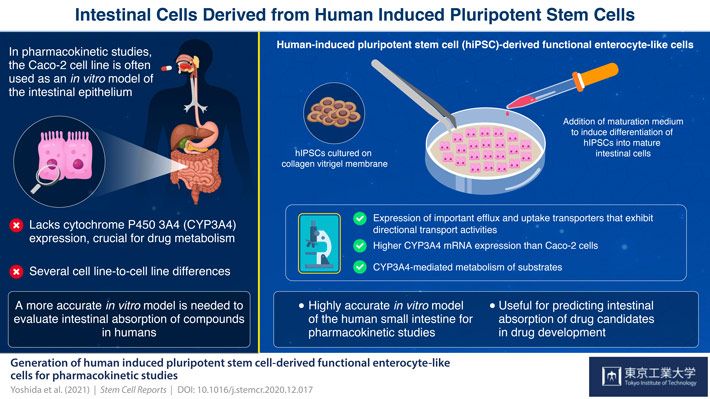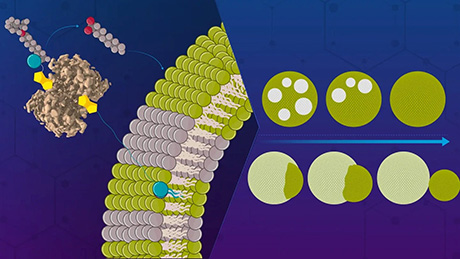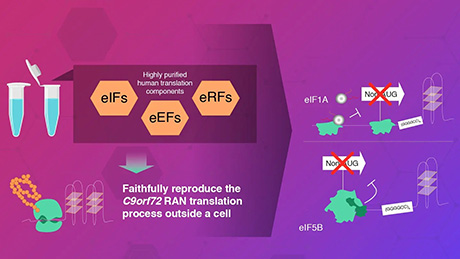Life Science and Technology News
Today's Stem Cell Special: Small Intestine on a Plate!
A team of scientists from Japan have found success in growing small intestinal cells, akin to those found in the human body, from human-induced pluripotent stem cells. The scientists used a procedure they previously developed on embryonic stem cells for this discovery. They claim that the grown cells can be used for laboratory studies focusing on human small intestinal drug transport and metabolism.

Enterocytes, which line the epithelium of the small intestine, are the sites of absorption and metabolism of most orally consumed medications. For this reason, studies on the absorption of novel oral drugs rely on in vitro or animal models to accurately recreate the environment of the small intestine. Currently, scientists widely use the human colon cancer cell line Caco-2 as a model of the intestinal epithelium. However, this has its drawbacks: Caco-2 cells have been derived from the colon; therefore, they more closely resemble the colon than the small intestine. For example, these cells do not express cytochrome P450 3A4 (CYP3A4), a protein critical for drug metabolism that is abundantly expressed in the small intestine. Moreover, Caco-2 cells tend to show high cell-line to cell-line variations.
To tackle these problems, scientists from the Tokyo Institute of Technology, The University of Tokyo, Kanto Chemical Co. Inc., Shionogi & Co., Ltd. and Shionogi TechnoAdvance Research Co., Ltd., developed novel enterocyte-like cells from human-induced pluripotent stem cells (hiPSCs), which can differentiate into any type of cell when provided with right growth factors.
By modifying a procedure that they previously used on human embryonic stem cells, the scientists initially grew cells that resemble the early stages of small intestine cells, called intestinal progenitor cells. Then, they cultured these progenitor cells on a collagen vitrigel membrane (CVM). Further, they treated the progenitor cells with a maturation medium containing 6-bromoindirubin-3'-oxime, dimethyl sulfoxide, dexamethasone, and activated vitamin D3. Their efforts resulted in the development of enterocyte-like cells that closely resembled actual enterocytes, expressing efflux transporter proteins regulating drug absorption as well as CYP3A4, which Caco-2 cells lack. Dr. Nobuaki Shiraki, Associate Professor at Tokyo Institute of Technology, and one of the corresponding authors of this study, adds, "We established an efficient culture procedure for generating enterocyte-like cells from hiPSCs by culturing the hiPSC-derived endoderm or intestine progenitor cells on CVM."
The scientists claim that these first-of-their-kind enterocyte-like cells can be used as an in vitro model of the small intestine for evaluating the intestinal absorption of drugs in humans. Elaborating on the advantages of using these cells for future studies, Dr. Shoen Kume, Professor at Tokyo Institute of Technology, and co-corresponding author of this study, comments, "The hiPSC-derived enterocyte-like cells established in this study could be used for the quantitative prediction of the intestinal absorption of drugs in humans under special occasions such as alteration of the functions of transporters/metabolic enzymes by drug-drug interactions as well as normal conditions."
Indeed, let us hope that the hiPSC-derived enterocyte-like cells would aid breakthrough research in future pharmacokinetic studies!
- Reference
| Authors : | Shinpei Yoshida1,2, Takayuki Honjo1, Keita Iino1, Ryunosuke Ishibe1, Sylvia Leo1, Tomoka Shimada3, Teruhiko Watanabe4, Masaya Ishikawa4, Kazuya Maeda5, Hiroyuki Kusuhara5, Nobuaki Shiraki1,* and Shoen Kume1,* |
|---|---|
| Title of original paper : | Generation of human-induced pluripotent stem cell-derived functional enterocyte-like cells for pharmacokinetic studies |
| Journal : | Stem Cell Reports |
| DOI : | 10.1016/j.stemcr.2020.12.017 |
| Affiliations : | 1 School of Life Science and Technology, Tokyo Institute of Technology 2 Drug Metabolism & Pharmacokinetics, Research Laboratory for Development, Shionogi & Co., Ltd. 3 Analytical Chemistry & Technology, Shionogi TechnoAdvance Research Co., Ltd. 4 Isehara Research Laboratory, Technology and Development Division, Kanto Chemical Co. Inc. 5 Laboratory of Molecular Pharmacokinetics, Graduate School of Pharmaceutical Sciences, The University of Tokyo |
* Corresponding authors' emails: shiraki@bio.titech.ac.jp; skume@bio.titech.ac.jp
- A Ferry Protein in the Pancreas Protects It from the Stress Induced by a High-Fat Diet | Life Science and Technology News
- Move over Akita: Introducing 'Kuma Mutant' Mice for Islet Transplantation Research | Tokyo Tech News
- Shoen Kume - Towards a new therapy for diabetes - Regenerating pancreas from ES and iPS cells | Research Stories | Research
- 2016 Tokyo Tech Challenging Research Award | Tokyo Tech News
- Kume and Shiraki Lab (Japanese)
- Researcher Profile | Tokyo Tech STAR Search - Shoen Kume
- Researcher Profile | Tokyo Tech STAR Search - Nobuaki Shiraki
- Department of Life Science and Technology, School of Life Science and Technology
- Shionogi & Co., Ltd.
- Kanto Chemical Co.,Inc.
- Graduate School of Pharmaceutical Sciences, The University of Tokyo
- Latest Research News
School of Life Science and Technology
—Unravel the Complex and Diverse Phenomena of Life—
Information on School of Life Science and Technology inaugurated in April 2016
Further Information
Professor Shoen Kume
School of Life Science and Technology,
Tokyo Institute of Technology
Email skume@bio.titech.ac.jp






